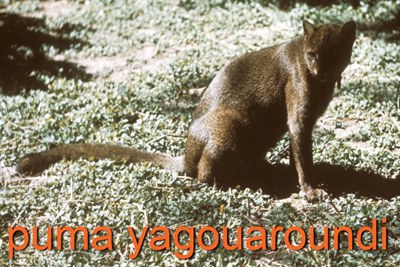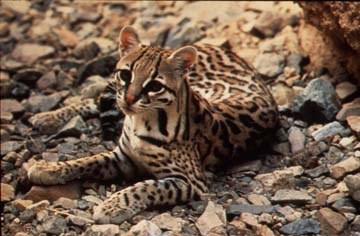Texas Cats

Texas is home to 7 different cat species including several endangered ones.
 Bobcat
Bobcat
The bobcat is a medium-sized, reddish brown cat about the size of a chow dog. Length of the adult is about 3 feet, 6 inches. Weight is 12-20 pounds, occasionally up to 36 pounds in old, fat males. Bobcats are highly adaptable felines and throughout most of their range in Texas have shown a marked ability to cope with the inroads of human settlement.
The bobcat's food consists mainly of small mammals and birds. Among the mammals found in bobcat stomachs, wood rats, ground squirrels, mice and rabbits supply the bulk of the diet. Occasionally deer are killed and eaten, but most of the deer meat found in bobcat stomachs has been carrion. The bobcat also preys upon domestic sheep, goats and poultry. The predatory damage is not great, except in rare instances.
The bobcat is the only native Texas cat which is important as a fur animal.
 Mountain Lion (Puma, Cougar)
Mountain Lion (Puma, Cougar)
The mountain lion is an unspotted cat. Males may be as much as 8 feet, 6 inches; females, 6 feet, 7 1/2 inches. Weight of three males averaged 184 (160-227) pounds; six females, 118 (105-133) pounds.
The mountain lion ranges over much of the Trans-Pecos of West Texas, the southern two-thirds of the Hill Country in Central Texas, and a large portion of the South Texas brushlands as well as in limited areas in North Central Texas. Within this range, the cat is most common in remote, thinly populated ranchlands but may be encountered almost anywhere. Changing land use patterns have resulted in reduced predator control efforts in many lion-populated areas. As a consequence, lion populations currently appear to be holding their own or increasing in the southern, central and western portions of the state.
Retiring and shy by nature, and largely nocturnal by habit, the mountain lion is seldom seen in its native haunts.
The diet of the mountain lion consists almost entirely of animal matter; but, like the domestic cat, it occasionally eats grasses and other vegetable matter. Deer and javelina are major food items; however, lions have been known to take elk and bighorn sheep as well as a variety of smaller animals.
Contrary to popular opinion, mountain lions rarely use caves as dens, preferring cliff crevices, overhanging ledges or enlarged badger burrows instead.
Except for a short breeding period of up to two weeks' duration, they lead a solitary existence.
Margay
Similar to the ocelot in color and color pattern, but smaller and more slender, is the margay. Total length is about 3 feet. Little is known of its breeding habits and food, but opossums are included in its diet.
It is known from Texas only on the basis of one specimen take at Eagle Pass by Col. S. Cooper over 100 years ago.
Remains of this diminutive cat were found in Pleistocene deposits along the Sabine River in Orange County, indicating the Margay ranged over a considerable portion of South Texas a few thousand years ago.
 Jaguarundi
Jaguarundi
The jaguarundi is a little larger than the domestic cat. It has two color phases, one grayish, the other reddish. Length of males is about 3 feet, 6 inches, of which the tail is more than half.
Considered extremely rare in Texas, the sleek low-slung jaguarundi inhabits the brush country of extreme southern Texas in Cameron, Hidalgo, Starr and Willacy counties. It reportedly eats rats, mice, birds and rabbits. Of all the cats, this one excels in ability to spring and jump, considering its size. No information is available on home life, growth and development. Numerous sightings of this species are reported each year, but they are difficult to verify because of the similarity to wild house cats.
The clearing of brushlands in the Rio Grande Valley threatens to destroy habitat in Texas.
*Wild populations of jaguarundi are believed to be currently extirpated from Texas.
Jaguar
The jaguar is the largest and most robust of the spotted American cats. Large males may grow as long as seven feet and weigh up to 200 pounds. Seldom venturing into the high, cooler inland areas, El Tigre inhabits the dense chaparral and timbered areas of the New World Tropics. This elegant cat shows a particular fondness for water-side habitats. It is extremely unlikely that this cat occurs in Texas although a rare visit by a wanderer from Mexico is possible. Last verified Texas records date from the turn of the century. The jaguar is now considered by most authorities to be extirpated from the state. Its food habits are not well known. In Mexico, it is known to prey on peccaries and in the Amazon region it catches fruit-eating fish using its sharp claws as gaff hooks, and it probably preys on deer and large ground-dwelling birds when such items are available.
Dr. E. W. Nelson reported that it is also fond of sea turtle eggs. The jaguar roams the beaches on spring nights, digs up the turtle eggs and enjoys a delectable repast.
Domestic(Feral Cat)
While the domestic cat has adapted itself in extraordinary fashion to man's customs, it has not altogether lost its wild traits. Often sleek, sleepy, and well-behaved by day, the cat, by night, may become a stealthy and serious predator.
In the course of a bobwhite quail experiment in East Texas, cats killed 8 quail and 10 cardinals in the experiment traps, on one occasion 6 quail at one time.
Cats also are known to catch and consume cotton rats and pocket gophers, and according to studies in Texas, cats consume Attwater's prairie chickens, meadowlarks, chicken flesh and feathers.
 Ocelot
Ocelot
The Ocelot is the most beautiful Texas cat. It is unique in that no two ocelot pelts are alike. Adult males may be as much as 3 feet, 10 inches long; females up to 3 feet. Weight is 20-35 pounds. Although the ocelot's food habits have not been determined completely, it has been reported that birds, including domestic poultry, are captured on their roosts. Rabbits, wood rats, mice of many kinds, as well as snakes and other reptiles, are also important items in the ocelot's diet. Now restricted to several isolated patches of suitable habitat in three or four counties of the Rio Grande Plains, the ocelot once ranged over the entire southern part of the state, with occasional records from north and central Texas.
Its population in Texas is chiefly threatened by habitat loss resulting from conversion of naturally-vegetated areas to agricultural land in South Texas and the Rio Grande Valley. Recent studies by the U.S. Fish and Wildlife Service and Texas Parks and Wildlife reveal that the ocelot is still found in scattered native brush areas of South Texas and some of these cats may now be using more open rangeland.